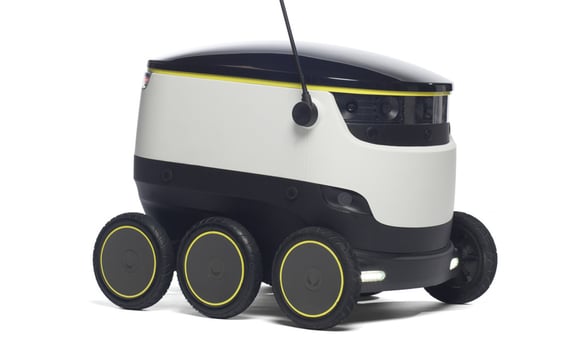REDWOOD LOGIN
Redwood PortalLTL
SCS
SCS Support
Rockfarm
Robotics is one of those subjects that captures the imagination. Sci-Fi futures where robots are commonplace regularly show up on the silver screen and on the pages of novels. But how close are we to this vision of the future? The answer may be closer than we think. Many startups and giants within the supply chain and transportation industries are investing heavily in R&D of robotics technologies. The application of robotics in the supply chain has the potential to revolutionize many current operations, especially last mile delivery. We have discussed the last mile and the challenges it brings in previous articles. However, it is an issue that is continuing to puzzle supply chain managers especially regarding e-commerce and the demand for faster delivery and fulfillment times. This article will recap some of the problems associated with last-mile logistics, discuss possible applications of robotics as well as identify strategies both start-ups and established companies are employing to capture the potential benefits of this technology.

Most would agree that the main challenge of the last mile is the uniqueness of individual customer demand. The massive variety in customer orders, order time and destination pose a massive problem for supply chain managers. Less-than-truckload is not exempt from these issues. LTL runs into problems when attempting to effectively consolidate shipments for the final leg of the journey. The uniqueness of customers makes it difficult to efficiently pack trucks and schedule deliveries. With the continued rise of e-commerce, this problem is only becoming more pressing. Many carriers are simply foregoing last mile delivery to avoid the hassle. Companies who remain in the game are now looking for any advantage they can find to effectively meet and capture last mile demand. One possible advantage firms are considering is the application of robotics in the last mile.
The prospect of robots in daily life seems fanciful, however, there are already current technologies being developed and implemented in today’s supply chain. We have previously discussed the growing prevalence of autonomous trucking and smart warehousing, but these and other technologies may become even more widespread. Tech start-ups are exploring possible applications of robotics in the supply chain. Skype creators Ahti Heinla and Janus Friis have founded a ground-delivery robotics company called Starship. Although the robots are still in beta testing phase, the potential benefits of this technology have already captured the attention of competitors and copy-cats. Since Starship’s initial unveiling, many similar companies have sprung up with comparable product offerings. The development of robots for the supply chain is not confined to start-ups. Many large industry players are also looking to implement autonomous technology into their operations. Amazon, for example, has invested heavily in the development of drones for home deliveries. These drones bring a wide array of potential benefits, including easier navigation of urban and rural areas as well as faster fulfillment times. Auto manufacturers are also embracing autonomy in their vehicles. Companies such as Ford, BMW, and Daimler are investing in the development of self-driving cars. The continuing saturation of automated vehicles in the market will make it considerably easier for transportation companies to implement the technology into their supply chains. These automated vehicles can help lessen the problems of the last mile through on-the-fly calculations of better driving routes, reduction of human error and inefficiencies, as well as 24-hour delivery.
The last mile continues to be a dilemma for supply chain managers. However, the growing application of robotics in the supply chain may solve many of its problems. If you have any further questions regarding the last mile, please do not hesitate to call us. We will be releasing an e-book encompassing a broad range of last mile topics for our loyal subscribers. If you are not yet a subscriber, take the time to fill out the form and gain access to valuable information and insight into a variety of supply chain and freight topics.